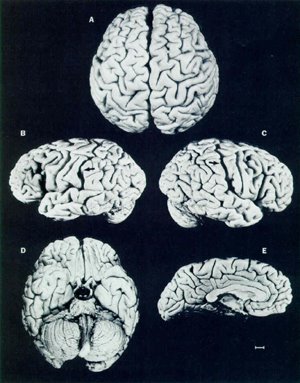It’s hard to imagine a more fundamental and ubiquitous aspect of life on the Earth than gravity, from the moment you first took a step and fell on your diapered bottom to the slow terminal sagging of flesh and dreams.
But what if it’s all an illusion, a sort of cosmic frill, or a side effect of something else going on at deeper levels of reality?
So says Erik Verlinde, 48, a respected string theorist and professor of physics at the University of Amsterdam, whose contention that gravity is indeed an illusion has caused a continuing ruckus among physicists, or at least among those who profess to understand it. Reversing the logic of 300 years of science, he argued in a recent paper, titled “On the Origin of Gravity and the Laws of Newton,” that gravity is a consequence of the venerable laws of thermodynamics, which describe the behavior of heat and gases.
“For me gravity doesn’t exist,” said Dr. Verlinde, who was recently in the United States to explain himself. Not that he can’t fall down, but Dr. Verlinde is among a number of physicists who say that science has been looking at gravity the wrong way and that there is something more basic, from which gravity “emerges,” the way stock markets emerge from the collective behavior of individual investors or that elasticity emerges from the mechanics of atoms.
Looking at gravity from this angle, they say, could shed light on some of the vexing cosmic issues of the day, like the dark energy, a kind of anti-gravity that seems to be speeding up the expansion of the universe, or the dark matter that is supposedly needed to hold galaxies together.
Dr. Verlinde’s argument turns on something you could call the “bad hair day” theory of gravity.
It goes something like this: your hair frizzles in the heat and humidity, because there are more ways for your hair to be curled than to be straight, and nature likes options. So it takes a force to pull hair straight and eliminate nature’s options. Forget curved space or the spooky attraction at a distance described by Isaac Newton’s equations well enough to let us navigate the rings of Saturn, the force we call gravity is simply a byproduct of nature’s propensity to maximize disorder.
Some of the best physicists in the world say they don’t understand Dr. Verlinde’s paper, and many are outright skeptical. But some of those very same physicists say he has provided a fresh perspective on some of the deepest questions in science, namely why space, time and gravity exist at all — even if he has not yet answered them.
“Some people have said it can’t be right, others that it’s right and we already knew it — that it’s right and profound, right and trivial,” Andrew Strominger, a string theorist at Harvard said.
“What you have to say,” he went on, “is that it has inspired a lot of interesting discussions. It’s just a very interesting collection of ideas that touch on things we most profoundly do not understand about our universe. That’s why I liked it.”
Dr. Verlinde is not an obvious candidate to go off the deep end. He and his brother Herman, a Princeton professor, are celebrated twins known more for their mastery of the mathematics of hard-core string theory than for philosophic flights.
Born in Woudenberg, in the Netherlands, in 1962, the brothers got early inspiration from a pair of 1970s television shows about particle physics and black holes. “I was completely captured,” Dr. Verlinde recalled. He and his brother obtained Ph.D’s from the University of Utrecht together in 1988 and then went to Princeton, Erik to the Institute for Advanced Study and Herman to the university. After bouncing back and forth across the ocean, they got tenure at Princeton. And, they married and divorced sisters. Erik left Princeton for Amsterdam to be near his children.
He made his first big splash as a graduate student when he invented Verlinde Algebra and the Verlinde formula, which are important in string theory, the so-called theory of everything, which posits that the world is made of tiny wriggling strings.
You might wonder why a string theorist is interested in Newton’s equations. After all Newton was overturned a century ago by Einstein, who explained gravity as warps in the geometry of space-time, and who some theorists think could be overturned in turn by string theorists.
Over the last 30 years gravity has been “undressed,” in Dr. Verlinde’s words, as a fundamental force.
This disrobing began in the 1970s with the discovery by Jacob Bekenstein of the Hebrew University of Jerusalem and Stephen Hawking of Cambridge University, among others, of a mysterious connection between black holes and thermodynamics, culminating in Dr. Hawking’s discovery in 1974 that when quantum effects are taken into account black holes would glow and eventually explode.
In a provocative calculation in 1995, Ted Jacobson, a theorist from the University of Maryland, showed that given a few of these holographic ideas, Einstein’s equations of general relativity are just a another way of stating the laws of thermodynamics.
Those exploding black holes (at least in theory — none has ever been observed) lit up a new strangeness of nature. Black holes, in effect, are holograms — like the 3-D images you see on bank cards. All the information about what has been lost inside them is encoded on their surfaces. Physicists have been wondering ever since how this “holographic principle” — that we are all maybe just shadows on a distant wall — applies to the universe and where it came from.
(page 2)
Subscribe to:
Comments (Atom)


.jpg)